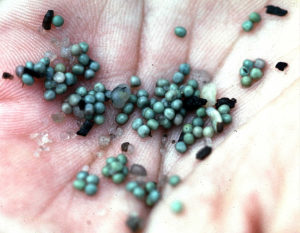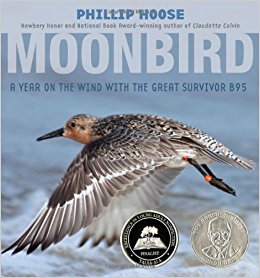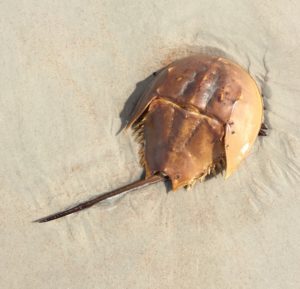by Teacher Peter Manzelmann
Can you feel it? They are beginning their crawl! Just a few miles to our west and south, something simply amazing is beginning to unfurl. Knowing that they are coming makes me almost hear them making their way along the bottom of the Delaware River!
The “they” are horseshoe crabs. We have all seen them at the beach or when we take a stroll along the DE Bay. These are ancient, ancient creatures. Horseshoe crabs, however, have quite the story to tell. Each spring (May and June) hundreds of thousands of horseshoe crabs come ashore mate and lay their small, green eggs on the Atlantic coast and DE Bay beaches. The crabs, while coming ashore, accidentally become overturned by waves, or become trapped in jetties or behind bulkheads. These creatures are vulnerable when their soft undersides are exposed to the sun and are an easy target for predators. Thousands die each year.
Why is this a huge concern? The miracle is that 100,000 hungry shorebirds are heading north from South America to breed in the Arctic. For example, the Red Knot, after flying 6,000 miles for four days without stopping, arrives on the DE Bayshore ready to double its weight on those little, horseshoe crab eggs. Our area is known as the world’s largest spawning grounds for the horseshoe crabs. How about that?

This important relationship between the crab egg laying and this migratory bird stopover is in danger. Overharvesting of horseshoe crabs for bait has reduced the number of eggs available for
shorebirds. Shorebirds are a vital part of the ecosystem for this should be a big concern. Numbers of both horseshoe crabs and shorebirds are declining. For this reason, New Jersey has a moratorium on possession of horseshoe crabs. I guess I broke the law when I showed my Friends School classes the male and female horseshoe crabs shells as I told them about the amazing Red Knot story! We are not allowed to remove live or dead crabs from the beaches. Also numerous DE Bay beaches and some Atlantic Coast areas are closed during the peak egg laying time (May 7 to June 7).
Last month, my wife, one of our sons, and I, attended a training at the East Point Lighthouse (a must see place near the end of Route 55) to receive a permit to flip the stranded crabs. We learned so much and will participate this month in a few walks. Many of these walks are open to the public (only on the open beaches). If you are interested in participating, go to the website ReturntheFavor.org. It could be another memorable family experience!
 In closing, our lives depend on horseshoe crabs. Literally! A component of their unique blue blood is used to test all injected drugs and implantable medical devices for contamination. Let’s help them out! Hey, check out the book Moonbird by Phillip Hoose. (I have copies to loan if you are interested.) It tells the story of a Red Knot who has been flying 18,000 miles every year for 20 years (the distance from the earth to the moon) dependent on its remarkable relationship with the horseshoe crab.
In closing, our lives depend on horseshoe crabs. Literally! A component of their unique blue blood is used to test all injected drugs and implantable medical devices for contamination. Let’s help them out! Hey, check out the book Moonbird by Phillip Hoose. (I have copies to loan if you are interested.) It tells the story of a Red Knot who has been flying 18,000 miles every year for 20 years (the distance from the earth to the moon) dependent on its remarkable relationship with the horseshoe crab.




Follow and Contact Us